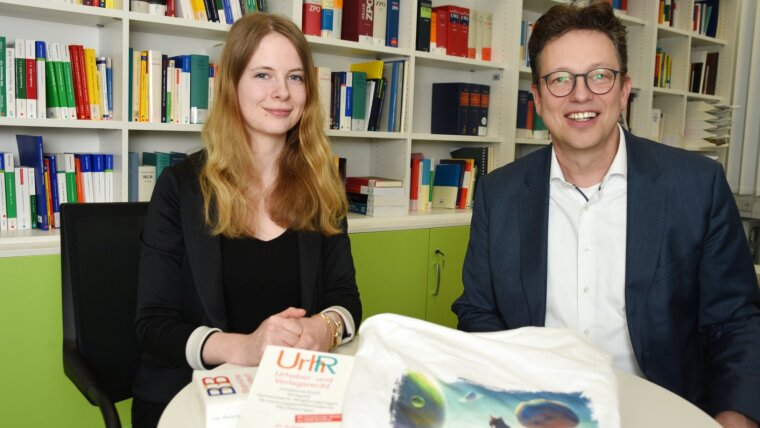
From the Pope in a thick puffer jacket to Vladimir Putin kneeling before the Chinese President, AI-generated disinformation is advancing to a whole new level. Yet, these forged images—which often go unrecognized to begin with—are far from the only AI-related challenge we face. Instead, the rise of AI technologies raises questions in various areas, including in relation to intellectual property. For instance: Who do the images generated using AI-based programmes actually »belong« to?
By Laura Weißert
Prof. Dr Volker Michael Jänich holds the Gerd Bucerius Chair of Civil Law and German and International Intellectual Property Law at the University of Jena. As he explains, AI brings new levels of nuance to his work on intellectual property law: »It has forced us to resharpen our previous research questions and reflect on why exactly we are protecting something.«
Intellectual property can include text and images that are protected by copyright as well as inventions and brands subject to patent law and trademark law. »These are human, intellectual creations that we consider worthy of protection,« explains Jänich. Copyrights, patent rights and design rights are all exclusive rights. This means that exploitation rights lie solely with the author, artist, inventor or designer.
For a work to be eligible for copyright protection, it must demonstrate a minimum degree of individuality or originality. Or, to put it another way, the work must express the personality of its author or artist. Whether an artist uses tools and aids like Photoshop to create their work is beside the point. But does the same apply to AI?
These cats are AI-generated. Nevertheless, the AI is not considered the creator of this image in a legal sense.
Illustration: DeepDreamCan AI be a creator in a legal sense?
Let’s consider an example: Viktoria Schrön, a research associate at Jänich’s Chair, uses a software called DeepDream to generate images. She wants to create »an image of two cats meeting on another planet« and specifies »digital art« as the style. Based on this original prompt, DeepDream uses an artificial neural network to generate an image (see right). »I didn’t like the first attempt, so I refined the prompt and made adjustments time and again until I was happy with the result.«
So, are these space-faring cats generated by DeepDream eligible for copyright protection? »Do I receive the copyright in my role as the user of the AI tool? Or do I only get it if I also programmed the AI myself? Does the copyright go to the AI or to nobody?« asks Schrön.
The first thing to remember is that an AI cannot be a creator or an inventor because, in copyright law and patent law, these terms refer to people—for the time being, at least. That leaves two options: either the image is not eligible for legal protection at all, or it is eligible for legal protection by the person who contributed to its creation. »The question here is whether the creative decisions that I made in advance by giving the AI a prompt are sufficient to justify eligibility for legal protection,« says Schrön. As it stands, academics are yet to reach a consensus on this issue.
Viktoria Schrön recently wrote her dissertation on the topic of AI and patent law. She believes that the distinction between patent law and copyright law lies in the level of personal involvement. »There’s still a connection between a patent and the inventor, of course, but that connection isn’t as decisive in patent law because of the constraints imposed by the laws of science. In copyright law, though, there are no limits to our imagination, which is why the decisive factor here is whether a work expresses a person’s spirit.« For this reason, Schrön believes it is conceivable that a person would be granted the intellectual property rights for an invention, even if AI were used in its creation.
AI training with copyright-protected material
There is, however, another side to the debate surrounding AI and copyright law. Generative AI cannot create new works out of thin air. Before programmes like ChatGPT are capable of generating texts, they need to be trained. And, before a software like DeepDream can generate images, it needs to be »fed« a wealth of existing images. This training also draws on copyright-protected works—often without the rights holders giving their consent or even being aware. Many creatives claim that artists and authors are being exploited by the developers of generative AI programmes. Consider, for example, asking AI to design a book cover: it will inherently draw on images created by human graphic designers.
Section 44b of the German Copyright Protection Act (UrhG), which was introduced in 2021, permits text and data mining, i.e. »the automated analysis of individual or several digital or digitized works for the purpose of gathering information, in particular regarding patterns, trends and correlations.« Rights holders do have the opportunity to implement a condition of use and object to text and data mining. However, whether this will have any practical impact is questionable, to say the least. From a legal perspective, it remains unclear whether this paragraph covers the training of AI models using copyright-protected works. For his part, Jänich has a clear opinion on the matter: he believes that such AI training represents a breach of copyright. At the same time, he concedes that there is currently no effectively legal protection to prevent this.
Yet, resistance is growing: The New York Times became the first major publisher to protest such practices and filed a lawsuit against Microsoft and OpenAI in late 2023. It believes that the two companies have infringed its copyright by »feeding« ChatGPT with millions of copyright-protected articles, thereby effectively operating at the newspaper’s expense. High-profile authors in the USA have also sued OpenAI because they believe that their books have been used to train AI models. Asked about similar legal suits in Europe, Jänich and Schrön are sceptical about their prospects of success.
The Axel Springer media group, for example, opted not to object to the use of its works and instead agreed to a partnership with OpenAI. Under this arrangement, the publisher is getting paid for providing ChatGPT with access to journalistic texts from Springer-owned publications.
Protecting copyrights in the age of AI
In the meantime, researchers are working on ways for artists to fight back against the unauthorized use of their works by AI. A recently launched tool called »Nightshade«, for example, can manipulate individual pixels of an image. Although such changes are imperceptible to the human eye, they disrupt AI programmes that use images manipulated in this way without permission. The »Nightshade« developers claim that the tool could cause the AI to produce an image of a handbag floating in space, even though the prompt was to produce a cow floating in space.
AI will undoubtedly make inroads into more and more areas of our lives in the future, raising new questions in the process. Legal scholars, however, have only just begun to assess such questions and examine intellectual property law in relation to AI. Finding answers will require new avenues for rights holders to protect their intellectual property. Ultimately, there is one thing AI cannot do: replace human creativity.
